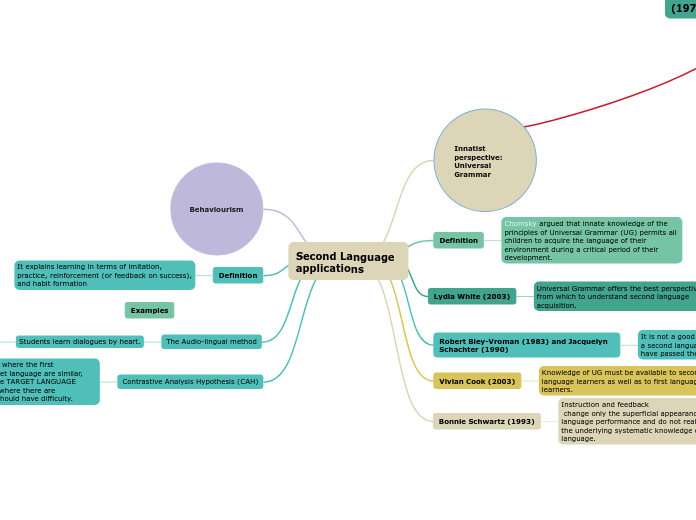Krashen's Monitor Model (1970)
5. Affective filter hypothesis
It is a metaphorical barrier that prevents learners from acquiring language even when appropriate input is avilable.
Feelings, motives, attitudes and emotional states.
4. Input hypothesis
Acquisition occurs when one is exposed to
language that is comprehensible and that contains words, grammatical forms, aspects of pronunciation that are just a stepbeyond that level.
3. Natural order hypothesis
The language features that are easiest to state (and thus to learn) are not
necessarily the first to be acquired.
Even some advanced second language speakers fail to apply basic rules in spontaneous conversations.
2. Monitor hypothesis
The learned system acts as an editor or'monitor', making minor changes and polishing what the acquired system has produced.
The speaker is concerned about producing correct language.
1. Acquisition-learning hypothesis
We 'learn' on the other hand through conscious attention to form and rule learning.
We 'acquire' as we are exposed to samples of the second language- with no conscious attention to language form.
Examples
Second Language applications
Adverbs are words or expressions that modify a verb, adjective, another adverb, determiner, clause, preposition, or sentence. Adverbs typically express manner, place, time, frequency, degree, level of certainty, etc.
Contrastive Analysis Hypothesis (CAH)
Compares three or more things or people, usually is compounded of the words 'the most' plus adverb.
According to the CAH, where the first
language and the target language are similar, learners should acquire TARGET LANGUAGE structures with ease; where there are differences, learners should have difficulty.
The Audio-lingual method
Answers the question:
Students learn dialogues by heart.
Mimicry and memorization
Write phrases as examples.
It explains learning in terms of imitation, practice, reinforcement (or feedback on success), and habit formation
Behaviourism
Answers the question:
Bonnie Schwartz (1993)
Instruction and feedback
change only the superficial appearance of language performance and do not really affect the underlying systematic knowledge of the new language.
Vivian Cook (2003)
Compares two things or people, usually is compounded of the word 'more' plus adverb.
Knowledge of UG must be available to second language learners as well as to first language learners.
Robert Bley-Vroman (1983) and Jacquelyn Schachter (1990)
Answers the question:
It is not a good explanation for the acquisition of a second language, especially by learners who have passed the critical period.
Lydia White (2003)
Universal Grammar offers the best perspective from which to understand second language acquisition.
Second Language Learners may sometimes need explicit information about what is not grammatical in the second language.
Definition
Answers the question:
Chomsky argued that innate knowledge of the principles of Universal Grammar (UG) permits all children to acquire the language of their environment during a critical period of their development.
Innatist perspective: Universal Grammar
Answers the question:









